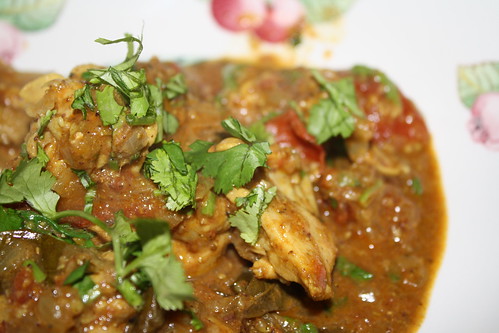A brief spate of cool weather saw us thinking about fitting in a curry. Andy initially wanted a lamb curry but we’d had arni souvlaki earlier in the the week so we ended up opting for chicken.
I chose this recipe, from Anjum’s New Indian, mainly because we had the ingredients all in house and ready to go. I’m not sure if Anjum Anand’s shows have made it on to Australian TV, but she did some fun programs in the UK where she showed curry enthusiasts that it was just as easy to cook a curry from scratch as it is to open a jar.
While this recipe doesn’t require a lot of cooking time for the meat, it does require time and it lends itself really well to being something you prep in the morning. Try throwing it together when you get home from work and you’re tired and hungry and I doubt it will turn out as well.
Begin by making a paste of about 1 tsp of crushed ginger, 5 cloves of garlic and a little water.
Next, take 2 black cardamom pods, give them a whack and put the seeds into a mortar. Add 2 cloves and grind and then mix in about ½ tsp of ground cinnamon. The black cardamom seeds smell amazing: they have the anise notes you’d expect but also a really strong menthol character. As in, really really strong. Make this curry if you have a cold!
In a large pan (in my case, the wok) heat some peanut oil, add about 20 curry leaves (washed and dried) and 1 onion, finely chopped. Anand uses a bay leaf but we have a curry leaf plant and I love the smell of them.
Now, boring part number one. Cook unti the onion browns. This takes ages. Don’t make the mistake of whacking up the temperature, because all that does is burn the onion. You need a medium temperature and you need to hang around and stir the onion so that it browns evenly. This part of making a curry bores me to tears but it is also well worth it.
When the onions are brown, add the garlic and ginger paste and, in my case, one dried Kashmiri chilli. Anand uses fresh, whole green chillis that you prick all over. But, as with the curry leaves, we have the dried chillis coming out of our ears so that’s what got used!
Cook this for a few minutes and then add your chicken. I used chicken thigh fillets (about 400g), cut into generous mouthful sized pieces. Anand always recommends using joints. Yes, the bones do mean flavour but generally I’m pretty lazy and thighs at least have more flavour than breast fillets. They’re also less likely to dry out.
Brown the chicken and then add the spices: 2½ tsp ground coriander, 1 tsp ground cumin, a pinch of red chilli powder (to taste, really), some turmeric and about 1 tsp of garam masala. And, of course, the cardamom, clove and cinnamon mix. Also add a good pinch of salt. Stir, and add three smallish tomatoes, cut into wedges. Top up the pan with some water and bring to the boil. Reduce the heat, cover and cook for a further 15 minutes.
Uncover the pan and increase the heat to high to brown and reduce your sauce. This is boring bit number two, but not as bad as the first as you don’t have to hang around quite as much. But you do really need to let it cook slowly for a while with the occasional stir. Suddenly you’ll notice the sauce has thickened and darkened.
When you’re ready to serve, mix through a generous handful of chopped coriander. Instead of rice, we had homemade naan bread. Delicious, and absolutely worth the hanging around and stirring!


this is possibly the first recipe that I’ve seen in a long, long time that uses curry leaves!! I love it! This sounds so yummy! 🙂
We use curry leaves a lot! In fact, I’m doing a chicken kofta curry tonight that uses them! It helps that we have a plant though as they can be tricky to track down & expensive.
I have also heard of people using them as a base for a marinade which is something I really need to investigate.
I love the way you describe this recipe – and it’s a great template for lots of Southeast Asian dishes. I haven’t seen curry leaves in the stores that are easily accessible to me (in the Mid-Atlantic US), but I looked up substitutes, and basil leaves will do, which are in abundance around here.
If you can find a plant – try growing your own. They’re easy to grow in a pot and don’t require a lot of care at all!